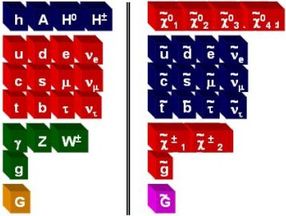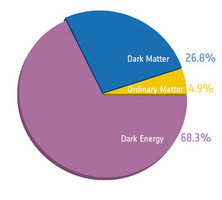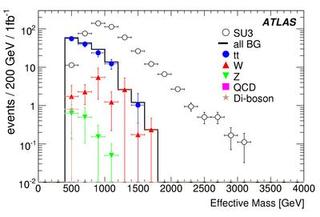Supersymmetry
 Supersymmetry (SUSY) is a theory beyond the Standard Model which introduces a new symmetry between fermions and bosons. In this theory, each known particle of the Standard Model is associated with a yet-to-discover supersymmetric particle. Each fermion is associated to a new boson, or "sfermion" (selectron, sneutrino, ...), and each boson is associated with a new fermion, or "bosino" (gluino, higgsino,...), all other quantum numbers being identical. No supersymmetric particle has been discovered so far: supersymmetry must hence be a broken symmetry to allow the superparticles to be more massive than their Standard Model partner.
Supersymmetry (SUSY) is a theory beyond the Standard Model which introduces a new symmetry between fermions and bosons. In this theory, each known particle of the Standard Model is associated with a yet-to-discover supersymmetric particle. Each fermion is associated to a new boson, or "sfermion" (selectron, sneutrino, ...), and each boson is associated with a new fermion, or "bosino" (gluino, higgsino,...), all other quantum numbers being identical. No supersymmetric particle has been discovered so far: supersymmetry must hence be a broken symmetry to allow the superparticles to be more massive than their Standard Model partner.
 This theory has many attractive features, such as:
This theory has many attractive features, such as:
- It can solve the so-called hierarchy problem which is related to the extreme fine-tuning needed in the Standard Model to stabilize the Higgs mass at the electroweak scale
- It allows a unification of the forces at high energy
- It can provide a good candidate to explain the cold non-baryonic dark matter found in the universe
 Finding the new particles predicted by supersymmetry is one of the major goals of the ATLAS experiment. Our group focuses on the search of SUSY in final states containing leptons (electrons, muons and in particular tau leptons), in addition to energetic jets and/or missing transverse energy. We are active in the analysis optimization, the estimation of Standard Model background from data, the study of appropriate triggers, the understanding of the missing transverse energy and also in the physics validation of the ATLAS software.
Finding the new particles predicted by supersymmetry is one of the major goals of the ATLAS experiment. Our group focuses on the search of SUSY in final states containing leptons (electrons, muons and in particular tau leptons), in addition to energetic jets and/or missing transverse energy. We are active in the analysis optimization, the estimation of Standard Model background from data, the study of appropriate triggers, the understanding of the missing transverse energy and also in the physics validation of the ATLAS software.

